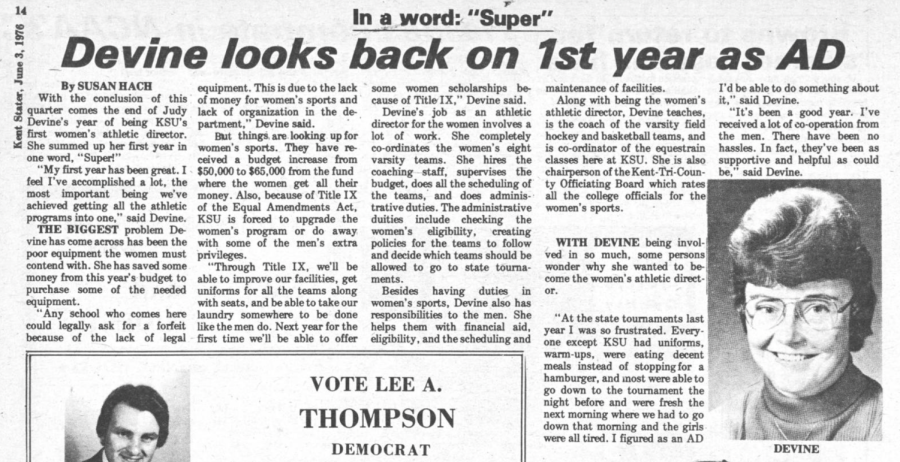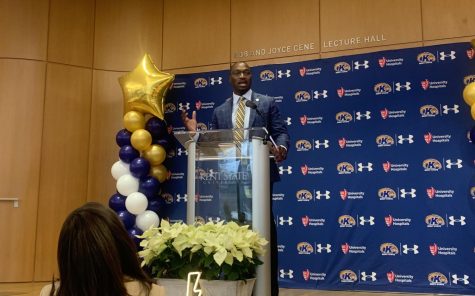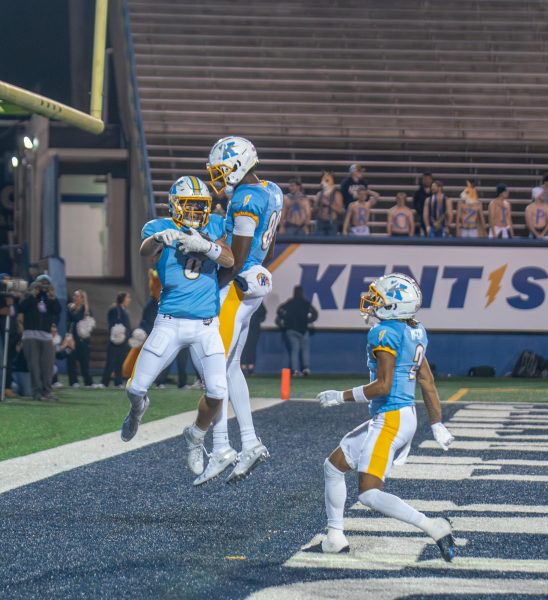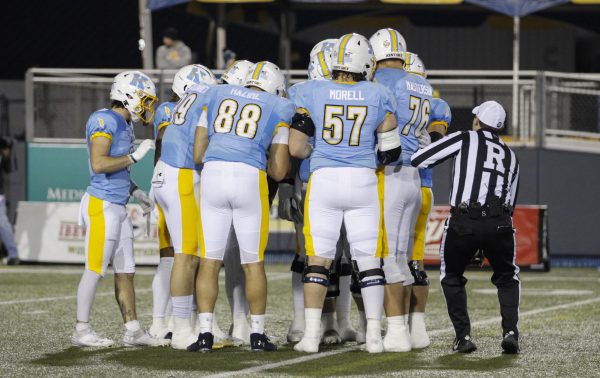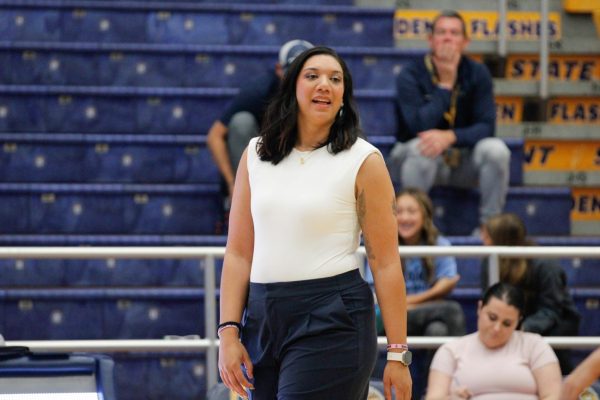A ‘low-key’ revolution: 50 years of Title IX at Kent State
Part two of three: From intramurals to 11 varsity teams, women’s athletics struggle, grow and evolve
Judy Devine reflects on her first year as women’s athletic director in an article from the June 3, 1976 Kent Stater.
To read part one, click here.
Title IX passed on June 23, 1972, but it did not bring immediate change.
Judy Devine, who had earned her masters in health and physical education, was the university’s first women’s basketball coach. And softball coach. And the athletic trainer for almost every women’s sport.
Barb Easlick was one of the first female varsity athletes after Title IX.
“We were using gym shoes from the PE classes,” she said. “We didn’t have uniforms or practice jerseys. We played whatever teams were available to us, but our seasons were so short compared to what the men’s seasons were.”
Easlick played field hockey, basketball and tennis at Kent State, graduating in 1977. She later coached women’s basketball at Malone College (now Malone University) and founded the school’s first softball team.
REAL CHANGE BEGINS
Kent State’s first step toward Title IX compliance came in 1975.
That summer, Devine got a call from the secretary of then-university president Glenn Olds.
“Judy,” the secretary said, “would it be possible for you to come back to campus for a meeting with the president? He’s found out that Title IX is a federal law, and we’re supposed to be in compliance with it.”
“[Olds] didn’t know any more about Title IX than we did,” Devine said, “but he thought it was something that would need a meeting.”
Women’s intramurals changed to women’s athletics, and the program merged with men’s athletics. Devine became assistant athletic director and the first coordinator of women’s athletics, reporting to athletic director Mike Lude. She was still not yet paid for her coaching and training duties.
“Those of us that were trying to fight for compliance with Title IX had a real uphill battle,” Devine said. “I was the only female there working against a bunch of guys whose societal attitude about the place of women in sport hadn’t really changed yet. You were bumping your head against the very low ceiling all the time and trying to say, ‘Well, this is what Title IX means.’ They didn’t really care.”

In her new position, Devine worked to find new equipment and uniforms and expand the training services and coaching staffs for women’s teams.
In fall of 1975, women’s sports were declared varsity teams at Kent State. Scholarships were offered for the first time in the 1976-77 season at $655 per team. Devine said she spread the money evenly among KSU’s 10 teams, letting coaches decide how to break up their share.
Chris Plonsky was on the women’s basketball team in that era.
“Judy came to us and said, ‘we have a little bit of scholarship money that the department has put aside for women’s basketball. I think we ought to have a team discussion about how it should be divided,’” Plonsky said. “We ended up saying it should go to the seniors. It wasn’t a lot, probably $150 or $200 apiece, but it was a start.”
In January 1976, tuition was $285 dollars per quarter, or $1,140 per year.
Funds were raised to about $6,000 per sport for the 1977-78 season. Devine had stepped down from her basketball coach position that year but remained head field hockey coach.
Devine gave out her scholarships to good players with the best academics. Easlick earned a $100 scholarship for field hockey in 1977.
“I thought, ‘Well, this is great and exciting,’” Easlick said. “But it was for academics. It wasn’t for my athlete performance.”
Devine had to start recording statistics for women’s teams. In her first years of coaching, women’s outdoor teams did not even have scoreboards.
Plonsky became the field hockey team’s statistician in 1976.
“Judy said, ‘We’re varsity now, and we’re going to need to chronicle this history. I want you to go over and to meet with this guy named Terry Barnard,’ who was the head sports information director,” Plonsky said.
Plonsky has worked in college athletics ever since. She is now the chief of staff and executive senior associate athletics director at the University of Texas.
In 1980-81, the Mid-American Conference began women’s competition, still under the AIAW. Kent State’s gymnastics team, led by legendary coaches Rudy and Janet Bachna, won the first-ever MAC tournament.
The NCAA held its first championship, which was for Division I women’s basketball, in 1982.
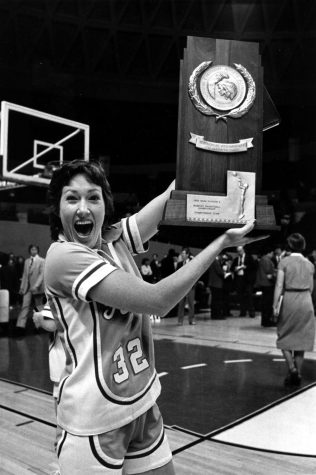
Louisiana Tech won the tournament. It was not yet called the “Final Four,” and news coverage was minimal.
Women’s sports were fully added into the NCAA in 1982.
“The public was now beginning to recognize that there were women’s sports, and we were developing some fans and a little bit of media coverage,” Devine said.
Women’s teams began to transfer from the AIAW to the NCAA, and by the summer of 1983, the AIAW ceased to exist. Unlike the AIAW, the NCAA was able to cover traveling costs for its first tournaments.
FINALLY, EQUALITY (SORT OF)
Kent State and other universities continued to slowly increase funding and support for women’s teams throughout the 1980s.
Devine said opportunities for women in athletics became closest to today’s level by the early 1990s.
“Everything started getting better and better,” Devine said. “By that time, almost all athletic departments had some sort of a female figure that represented athletics. Then, as we started creating coaching positions and put some salaries with it and as women began to graduate from college, we began to get people who had better expertise. That improved the quality of practices and competition.”
In the 1981-82 season, 64,390 women athletes competed in NCAA championships across all three divisions, according to a 2018 NCAA Sports Sponsorship and Participation Rates Report. In the 1990-91 season, participation increased to 92,473.
From 1981 to 2022, Kent State women’s teams won 68 MAC championship/tournament titles.
Other milestones include:
- First MAC championship/title: Gymnastics in 1981
- First NCAA appearance: Women’s basketball in 1982
- League championships:
– Golf: 23 titles in the 24 year-history of the sport, reaching at least the NCAA tournament 21 times. The team finished tied for fifth in the nation twice.

– Field hockey: 18 regular-season titles, 12 MAC Tournament titles and made the NCAA tournament 10 times
– Gymnastics: Nine regular-season titles, 12 conference meet titles and reached the NCAA semifinals in 2011. The team won at least four Ohio state championships from 1975-1978 but the record book statistics are incomplete for other years.
– Softball: Six regular-season championships, three MAC Tournament titles and advanced to the Women’s College World Series in 1990. The team won the Ohio Association for Intercollegiate Women’s Athletics championship in 1977.
– Basketball: Five regular-season titles, three tournament titles and advanced to the NCAA Tournament five times.
#GoFlashes x #TitleIX50 pic.twitter.com/5u8r30uuqJ
— Kent State Athletics (@KentStAthletics) February 9, 2022
– Track: Five indoor titles and eight outdoor
– Soccer: Three regular-season titles and one MAC Tournament title
– Cross country: Won the MAC once, in 2004
- Olympians: Betty-Jean Maycock competed for the U.S. gymnastics team in 1960. In 1996, Pauline Maurice played softball for Canada. In track, Kim Kreiner competed for the U.S. team in the javelin throw in 2004 and 2008, Danniel Thomas-Dodd in the shot put for Jamaica in 2016 and 2020 and sprinter Nicole Yeargin for Great Britain in 2020.
- Only retired jersey: #13 Bonnie Beachy, basketball, 1979-1982. She is the highest-scoring player in program history from both KSU men’s and women’s basketball. She was the first All-American women’s basketball player in school history.In the last 25 years, Kent State added soccer (1997), women’s golf (1998) and lacrosse (2018) as varsity sports.
According to Athletic Director Randale Richmond, this fiscal year, the lacrosse program will receive another full-ride equivalent scholarship, since it has not reached its full scholarship allotment. The scholarship could be given to one student or split up among players.
Today, Kent State has 11 women’s teams compared to eight men’s sports, counting indoor and outdoor track separately.
Isabella Schreck is sports editor. Contact her at [email protected].
Part one: Judy Devine, a pioneer in women’s sports at Kent State, played and coached during the beginnings and through the growth of collegiate women’s athletics.
Part three: The path to equality for women in Kent State’s athletic department is not always smooth. A new director is charting his own path.
Izzy is a junior journalism major who loves reading, writing, talking — and most importantly, asking a lot of questions. She previously was Sports Editor...


